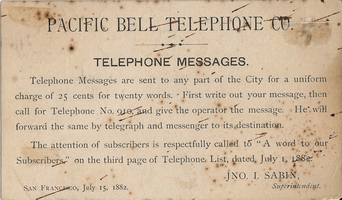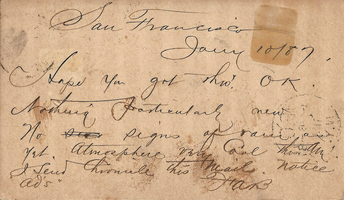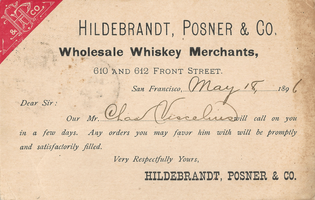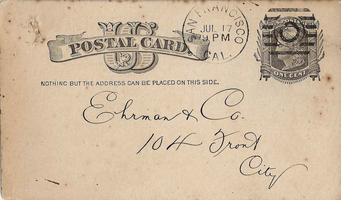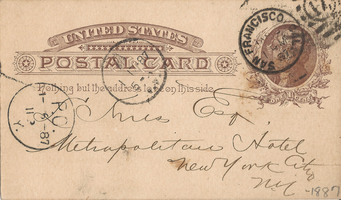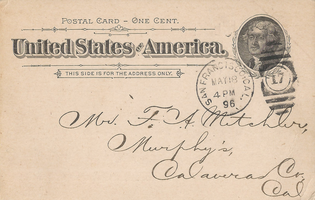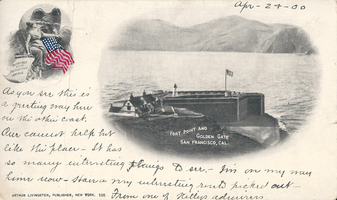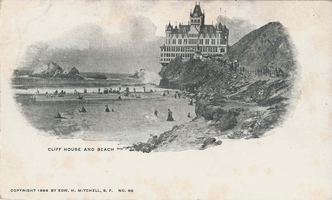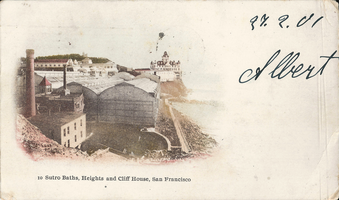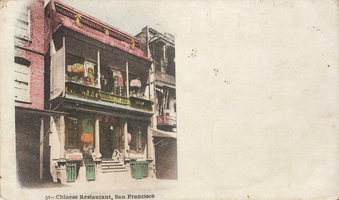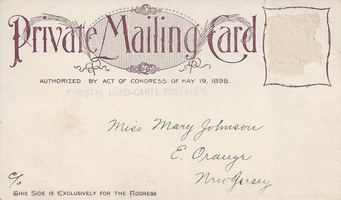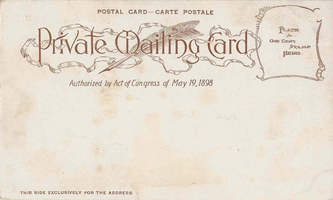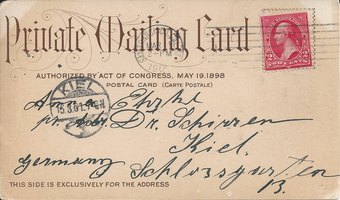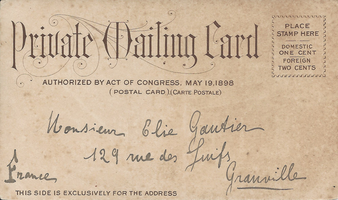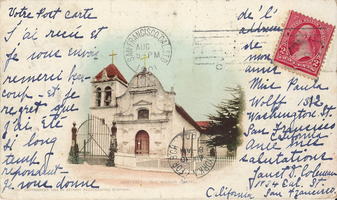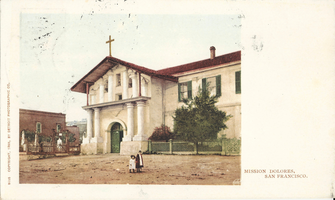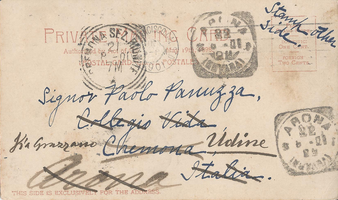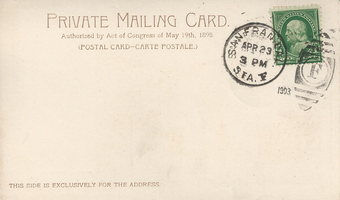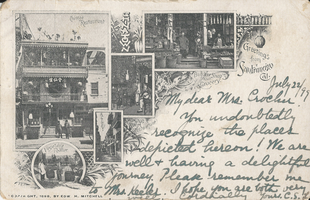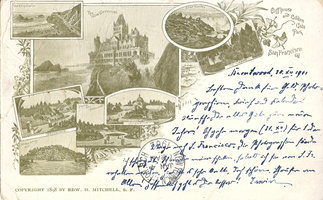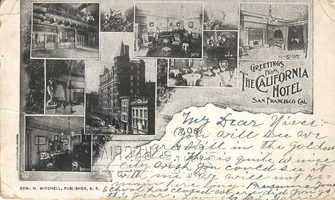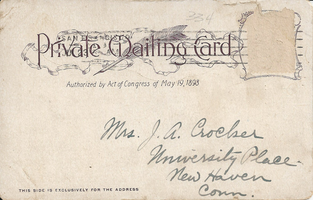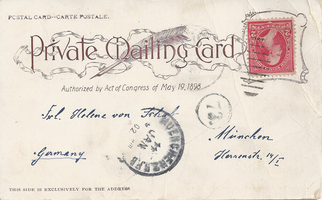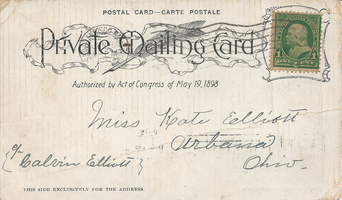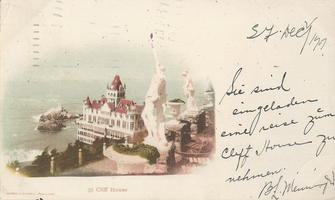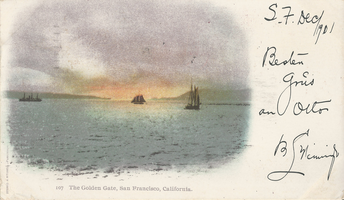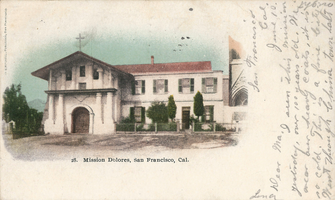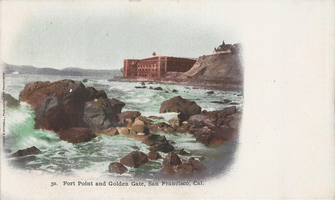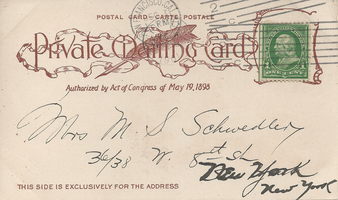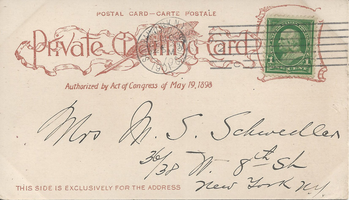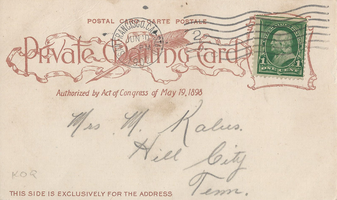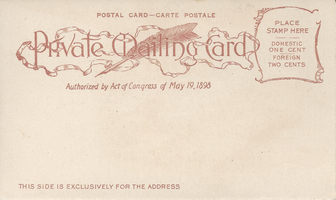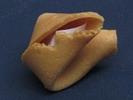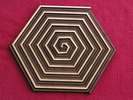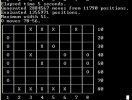Early Postcards
Before 1898, postage was 1¢ for an official Post Office card ("U.S. Postal Card") but 2¢ for a privately published card. Letter postage was also 2¢, so there was little motivation to use a private postcard rather than a letter. Only the address could be written on the address side of the card. As these examples show, cards were used for both personal and business purposes.
- US Postal, message dated 7/15/1882 (postmarked SF 7/17/yyyy, postmark year not printed), is the oldest card in my collection. Pacific Bell Telephone Co. advertises its message service: messages hand-delivered anywhere in S.F. at 25¢ for 20 words.
- US Postal, postmarked SF 1/03/1887.
- US Postal, postmarked SF 5/18/1896. Addressee Mitchler's hotel in Murphys still stands in 2021, now called Murphys Hotel, but I doubt that they serve Hildebrandt's whiskey now.
The Private Mailing Card Act of 5/19/1898 fixed domestic postage for all postal cards at 1¢, making privately issued cards competitive with Post Office cards. The Act required the back of each card to say "Private Mailing Card". The back could be used only for the address, so the front layout usually included ample blank space for a message. Many private mailing cards use a soft edge border around the image, resulting in a very distinctive look. The government relaxed the "Private Mailing Card" restriction on 12/24/1901, allowing cards to use "Post Card" on the back instead, so private mailing cards were only in use for a few years.
- Livingston 105 dated 4/24/1900, addressed but presumably never mailed (no cancellation, stamp removed).
- Mitchell 50. Many other Mitchell cards are shown below.
- Unknown publisher 10, written 2/27/1901, postmarked SF 3/01/1901 and Kiel 3/15/1901. Cliff House from Sutro Baths shows other postcards using the same image.
- Unknown publisher 31, same back as previous card, addressed but not mailed, ca. 1902. It shows Tin How temple (not "Chinese Restaurant" per caption); Chinatown: Tin How Temple gives more details.
Not shown: Unknown publisher 2 (Seal Rocks).
Detroit Photographic Co. was the most prominent national postcard publisher at the start of the 20th Century. Unlike most local publishers, Detroit used their own photos rather than photos purchased from local photographers.
- Detroit 173 © 1899, with postmarks from SF 8/dd/1901 [postmark day illegible], NY 8/10/1901, and Italy 8/21-22/1901.
- Detroit 5655 © 1898, postmarked SF 4/23/1903 (but not addressed!), my only private mailing card with a hard edge image border.
Edward H. Mitchell (1867-1932) was a prolific local San Francisco postcard publisher from the late 1890s through the early 1920s. Multiview cards like these were popular in the early years of the 20th Century.
- Mitchell, written 7/22/1899, is the oldest PMC in my collection. The inset photos show Chinatown.
- Mitchell, written 12/30/1901. Inset photos show "The Old Cliff House" (Cliff House #2, destroyed by fire in 1894) as well as "The New Cliff House" (Cliff House #3).
- Mitchell, postmarked SF 6/06/1902. The California Hotel also appears in a later Mitchell private mailing card. Chinatown: Private Mailing Cards shows several more Mitchell private mailing cards.
Mitchell's colored private mailing cards are typically of better quality than his poorly printed later cards.
- Mitchell 55, postmarked SF 12/03/1901.
- Mitchell 107, postmarked SF 12/03/1901; same sender/addressee/date as preceding.
- Mitchell 28, postmarked SF 6/10/1902.
- Mitchell 30.
All the private mailing cards in my collection are listed here, including many not shown above. Gruber has a Private Mailing Card era back but obviously post-dates the 1906 earthquake (per caption). The much later Mark Hopkins also identifies itself as a private mailing card, possibly because the hotel offers to stamp and mail it.
Steve's SF postcard pages:
